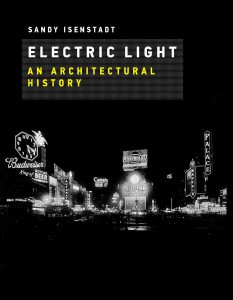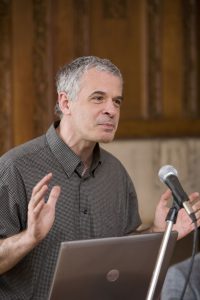How electric light created new spaces that transformed the built environment and the perception of modern architecture.
In this book, Sandy Isenstadt examines electric light as a form of architecture—as a new, uniquely modern kind of building material. Electric light was more than just a novel way of brightening a room or illuminating a streetscape; it brought with it new ways of perceiving and experiencing space itself. If modernity can be characterized by rapid, incessant change, and modernism as the creative response to such change, Isenstadt argues, then electricity—instantaneous, malleable, ubiquitous, evanescent—is modernity’s medium.
Professor Isenstadt’s five fascinating case studies of the architecture of electric light show how it created new kinds of space, precipitated new social relations, and simultaneously led to bedazzlement and obscurity.
David E. NyeSenior Research Fellow, University of Minnesota. Author of American Illumination: Urban Lighting, 1800–1920s and Electrifying America: Social Meanings of a New Technology, 1880-1940
Isenstadt shows how the introduction of electric lighting at the end of the nineteenth century created new architectural spaces that altered and sometimes eclipsed previously existing spaces. He constructs an architectural history of these new spaces through five examples, ranging from the tangible miracle of the light switch to the immaterial and borderless gloom of the wartime blackout. He describes what it means when an ordinary person can play God by flipping a switch; when the roving cone of automobile headlights places driver and passenger at the vertex of a luminous cavity; when lighting in factories is seen to enhance productivity; when Times Square became an emblem of illuminated commercial speech; and when the absence of electric light in a blackout produced a new type of space.
For historians of architecture, this book provides valuable insights into the invention and evolution of this essential but underappreciated tool for creating modern spaces. And general readers will likewise enjoy this thoughtful and richly illustrated guide to what the author aptly calls ‘modernity’s medium.’ We see electric light every day, but after reading this book, you will look at it in new ways.
Ernest Freeberg, author of The Age of Edison: Electric Light and the Invention of Modern America
In this book, the first sustained examination of the spatial effects of electric lighting, Isenstadt reconceives modernism in architecture to account for the new perceptual conditions and visual habits that followed widespread electrification.
In focusing on selective histories of what now seem largely mundane, unremarkable innovations in illumination, Sandy Isenstadt reveals the initial astonishment that greeted their world-changing capacities, the sense of wonder that prefigured their rapid transformation into institutionalized, standardized modern technologies. In five dazzling chapters, we learn of the amazingly instantaneous metamorphoses of space wrought by the humble light switch, the instrumental deployment of electric radiance to increase factory production, the phantasmagorical transfiguration of the nocturnal road in the glare of the car’s headlights, the lurid commercial cajolery of Times Square and the multivalent advent of the blackout. Furnishing the account with bounteous empirical detail and theoretical elegance throughout, Isenstadt has written a fascinating, engaging book that will prove essential for historians and social scientists of all stripes.
Tim Edensor, Manchester Metropolitan University, UK, author of From Light to Dark: Daylight, Illumination, and Gloom
Purchase Electric Light Today!
Sandy Isenstadt is a Professor in the Art History Department and Director of the Center for Material Culture Studies at the University of Delaware. He is the author of The Modern American House: Spaciousness and Middle-Class Identity.
Click here for Dr. Isenstadt’s full biography and other publications.





